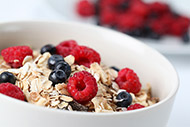
When stocking your healthy kitchen this summer, keep your eye out for these foods.
Bell Peppers
Nutrition: Bell peppers are loaded with vitamins and plant chemicals that act as antioxidants, including vitamins C, E, and carotenoids. Like cruciferous and allium vegetables, bell peppers also contain sulfur compounds that may protect against cancer.
Varieties: Bell peppers are no longer limited to red and green. Look for yellow, orange, and many shades of purple to add color to your favorite recipes. Bell peppers are not spicy. Red, orange, and yellow varieties are sweet, while green and purple varieties have a slight bitterness.
How to use: You’ll retain many of the nutrients in bell peppers by eating them raw or cooking them at low heat for a short time. However, grilling or baking them will not strip away all nutritional benefits.
Preparation Options:
- Dice bell peppers and add them to leafy salads, pasta salads, soups, salsas, or pizzas.
- Grill whole bell peppers and then slice them to serve with grilled meats, or add them to kabobs.
- Roast bell peppers with root vegetables.
- Stuff them with a mix of meat or vegetables and bake.
- Add bell peppers to your homemade juices.
Corn
Nutrition: Corn provides fiber, folate, thiamin, vitamin C, magnesium, and a variety of disease-fighting antioxidants.
Varieties: Sweet corn most often has white kernels, yellow kernels, or a combination of both colors, but varieties with purple or red kernels are becoming more available.
Preparation Options:
- Grill or boil fresh corn on the cob and top with herbs before serving.
- Remove the kernels. Cook with bell peppers in a skillet, or roast them in the oven. The cooked corn kernels can be stirred into salsa, eaten alone, or sprinkled on salads and pizzas.
Cucumbers
Nutrition: Cucumbers provide a variety of vitamins and minerals, including vitamin K, vitamin C, and potassium. Cucumbers also contain phytonutrients called cucurbitacins, which may have anti-cancer benefits.
Varieties: There are many types of cucumbers available, and they vary in length, width, color, and skin thickness. English cucumbers are long with thin skin and few seeds. Garden cucumbers are shorter with thick skins. Persian cucumbers are often smaller with tender skin and bright green color.
Preparation Options:
- Snack on small Persian cucumbers with your favorite hummus.
- Slice English cucumbers to stack on sandwiches.
- Use garden cucumbers to make summer cucumber salads and slaws.
Eggplant
Nutrition: Eggplant is a source of dietary fiber, thiamin, vitamin B6, potassium, and folate. The skin of purple eggplants contains nasunin, which is an antioxidant that has been linked to protecting brain cells.
Varieties: Most eggplants are large, oblong, and deep purple. Some varieties, like Asian eggplants, can be long and thin or small and round. They range in color from green and white to light purple.
Preparation Options:
- Add chopped eggplant to stir-fries and curries.
- Marinate and grill large eggplant slices.
- Cut the eggplant in half, and scoop out some of the inside. Stuff with whole grains, vegetables, and lean meats, and bake until tender.
Hot peppers
Nutrition: Peppers contain vitamin A, potassium, vitamin C, and folic acid. The capsaicin found in hot peppers is linked to reduced appetite and increased metabolism.
Varieties: Varieties include Mexican jalapeños, Scotch Bonnet peppers from the Caribbean, and Bird’s Eye chiles of Thailand. Hot peppers come in all sizes and levels of heat. Colors include green, yellow, red, orange, and purple.
Tip: You can reduce some of the heat of hot peppers by removing the seeds.
Preparation Options:
- Add diced hot peppers to omelets, stir-fries, soups, and salsas.
- Puree hot peppers into pasta sauces.
- Slice and add them to sandwiches or pizzas.
Watermelon
Nutrition: Watermelons provide potassium, magnesium, thiamin, and vitamins A, C, and B6. The fruit also contains the cancer-fighting antioxidant lycopene. There is also evidence that the nutrients in watermelons may boost the production of the amino acid arginine, which benefits cardiovascular health.
Varieties: While the giant green watermelon with the red center is the most common type, watermelons can be found in many forms. Sizes range from large to small. Skins can be light green (almost white), and the flesh can even be yellow-orange. Seedless varieties are also available.
Preparation Options:
- Top salads with cubed watermelon.
- Drizzle slices with balsamic vinegar and sprinkle with feta cheese and herbs.
- Add chunks of watermelon to grilled fruit kabobs.
- Grill slices and serve warm.
- Add watermelon to your homemade juice or blend it into smoothies.



 3 Healthy Lunches for Your Work Week
3 Healthy Lunches for Your Work Week
 5 Tips for Stretching Your Budget for Healthy Food
5 Tips for Stretching Your Budget for Healthy Food
 Best Ways to Reduce Added Sugar
Best Ways to Reduce Added Sugar
 Healthy Tips to Lighten Up Picnic Foods
Healthy Tips to Lighten Up Picnic Foods
 Do You Need to Drink Milk?
Do You Need to Drink Milk?
 Tips to Keep Track of Water Intake
Tips to Keep Track of Water Intake
 20 Superfoods to Eat Now
20 Superfoods to Eat Now
 Butter vs. Margarine: What’s the Best Choice?
Butter vs. Margarine: What’s the Best Choice?

 Pinterest
Pinterest RSS Feed
RSS Feed